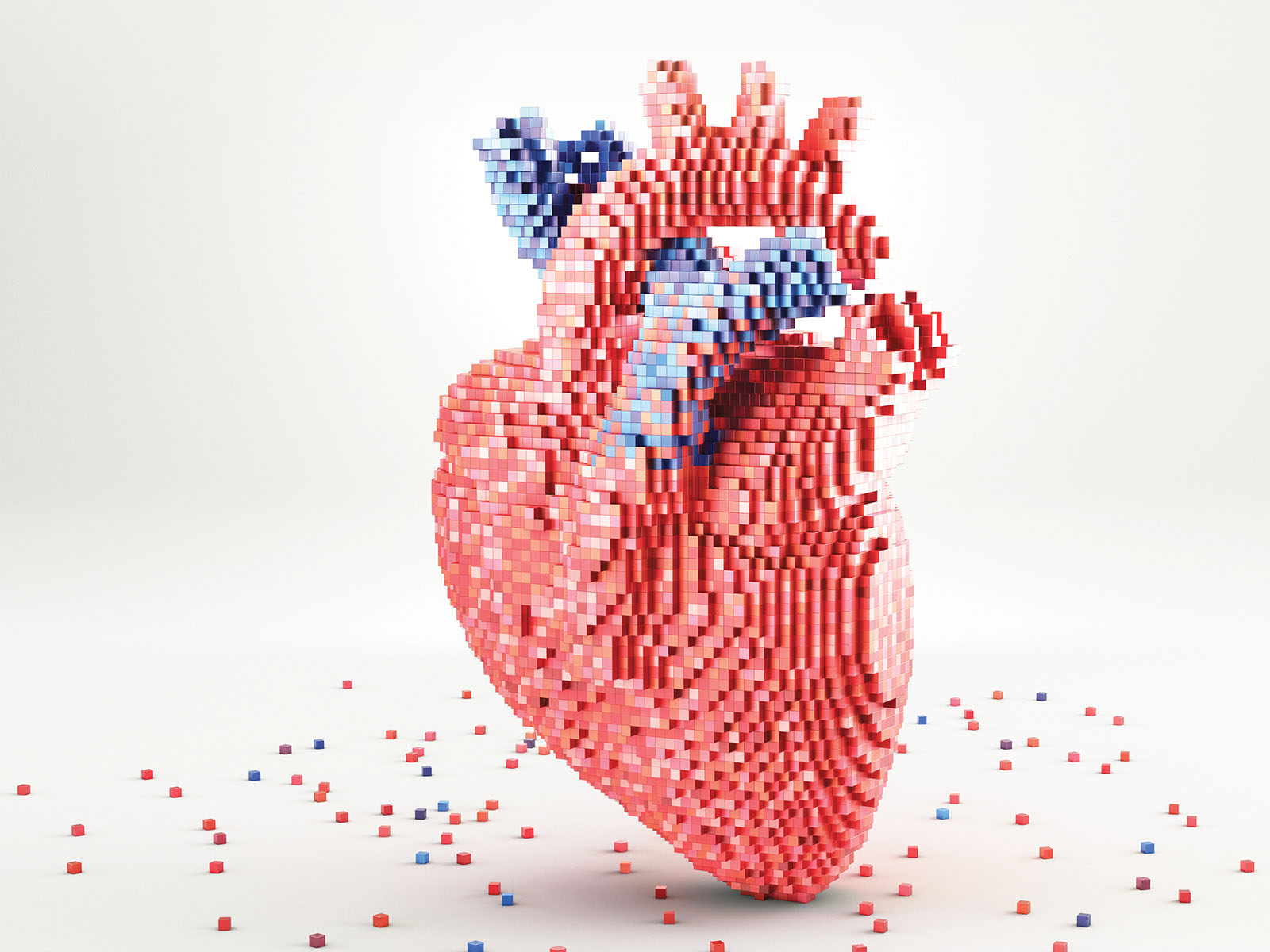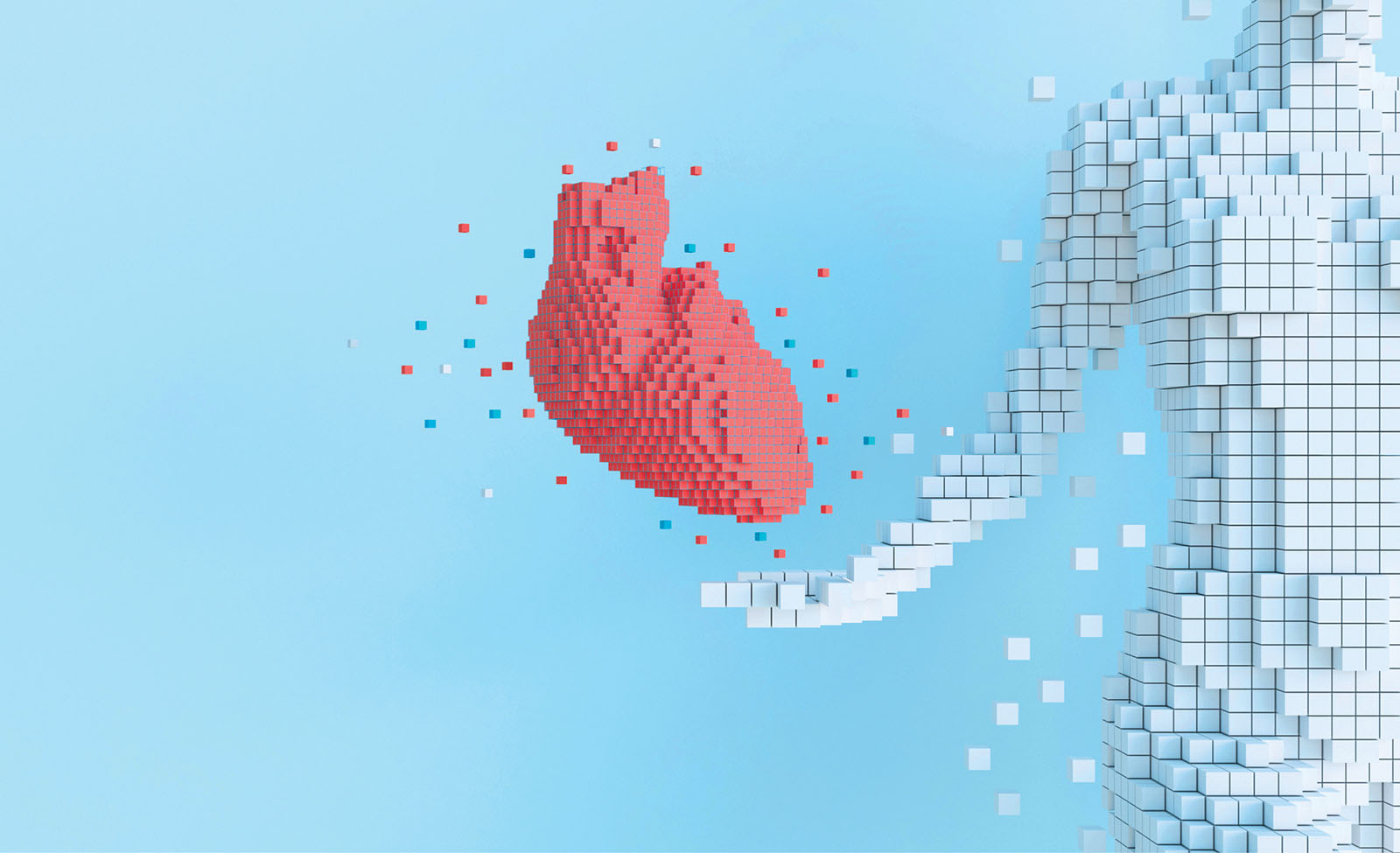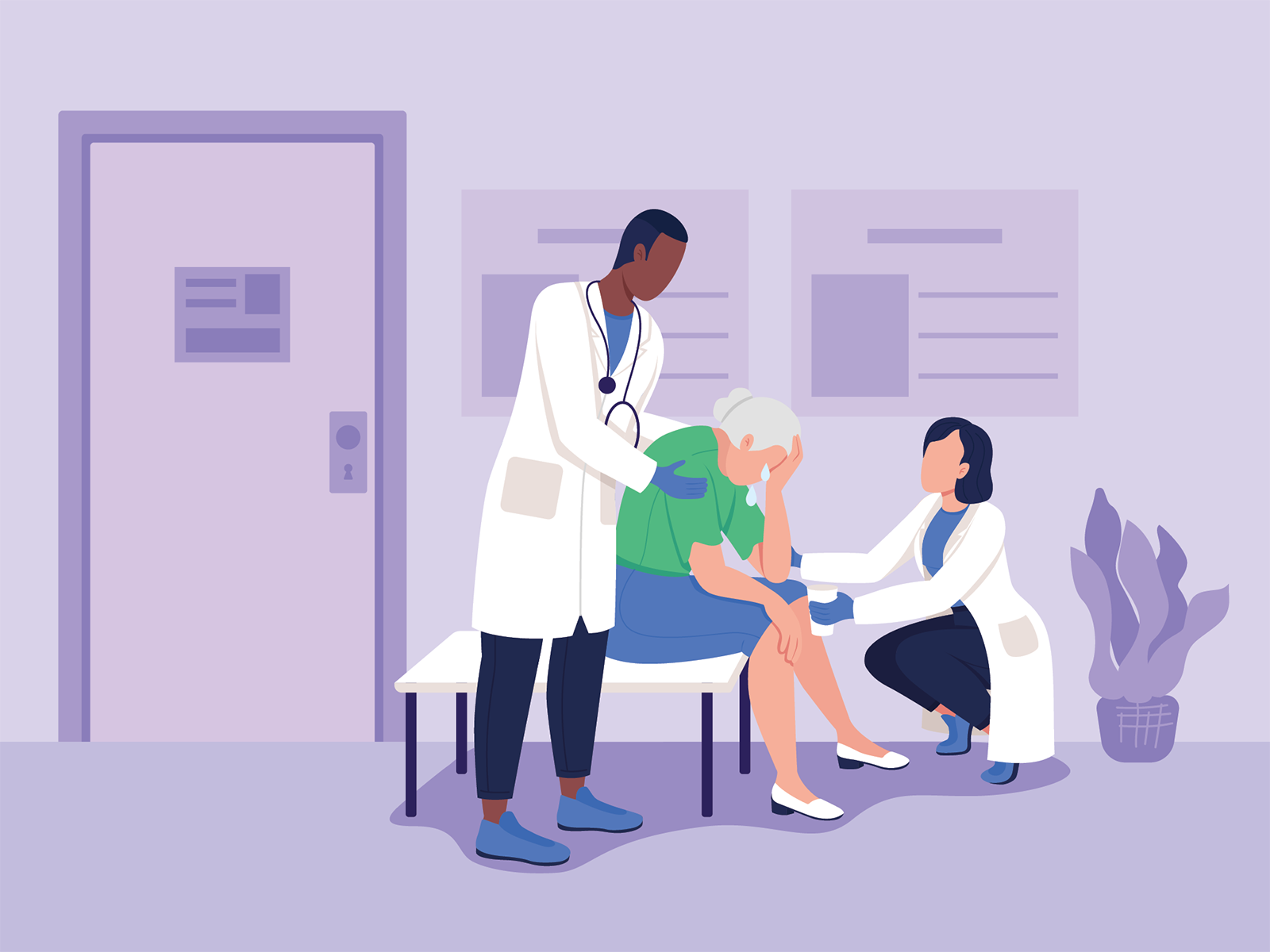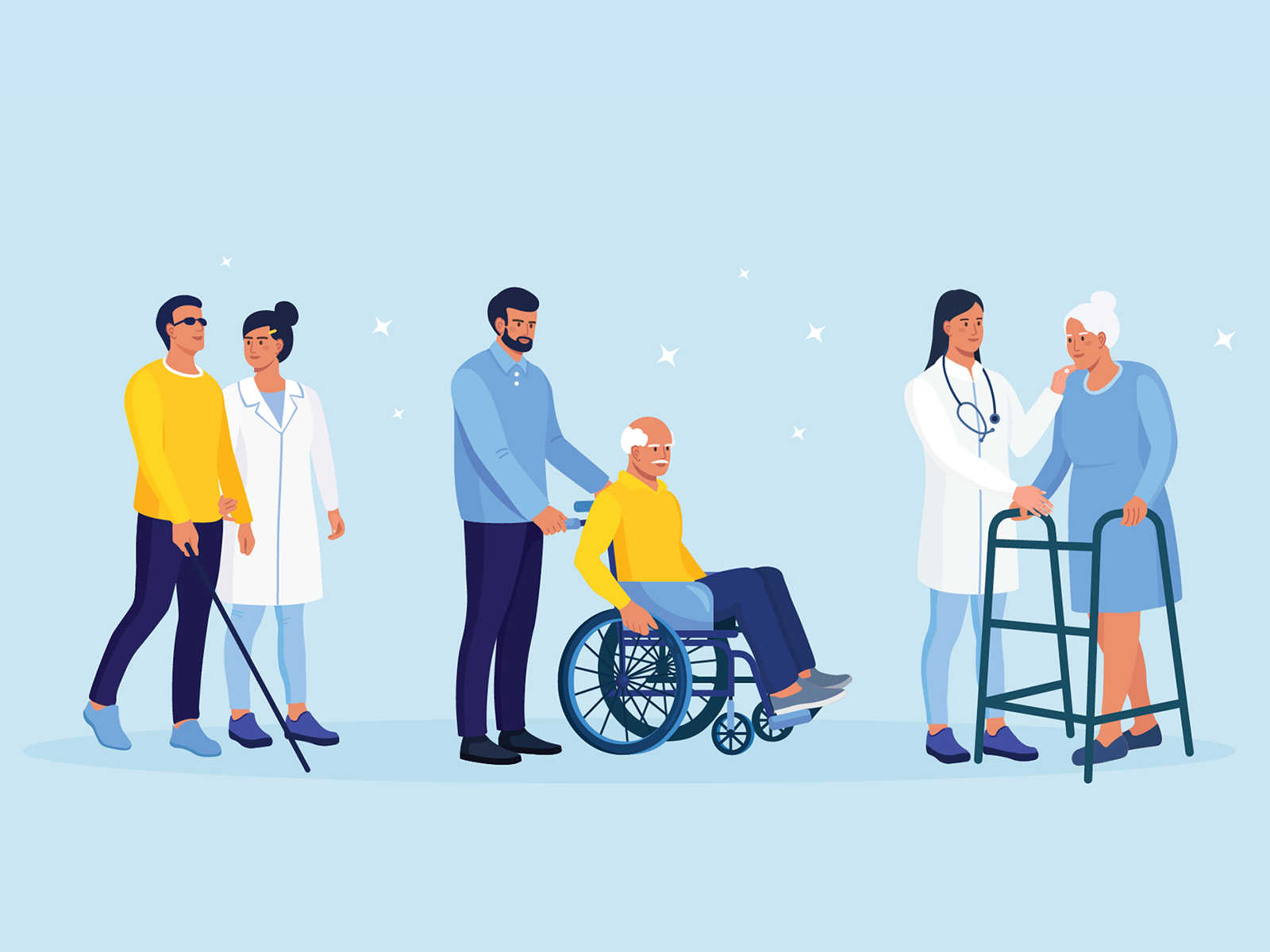
Issue 46
May 2023
AFFAIRS OF THE HEART
By Associate Professor Mark Chan, Deputy Programme Director, Cardiovascular Disease Translational Research Programme, NUS Yong Loo Lin School of Medicine (NUS Medicine) & Senior Consultant Cardiologist, National University Heart Centre Singapore (NUHCS), National University Health System (NUHS) with contributions from co-authors listed at the end of the article

I still vividly recall how hypertension, or high blood pressure, was treated 10 years ago.
A patient visits a doctor’s clinic, often waiting 30 minutes or more to see a doctor for five minutes or less. The doctor measures the patient’s blood pressure and then prescribes a first-line antihypertensive medication for lowering blood pressure. The patient then queues up at the pharmacy for another 30 minutes or more before getting the prescribed supply of medication. A repeat consultation is scheduled for another blood pressure measurement in several weeks and the entire process repeats itself.
Fast-forward 10 years later to the present day and the patient experience has undergone a revolutionary transformation. A patient with hypertension measures his own blood pressure at home and transmits his blood pressure measurements wirelessly to the cloud. A nurse practitioner monitors the patient’s blood pressure remotely and adjusts the patient’s antihypertensive medications remotely. The nurse practitioner prescribes the appropriate antihypertensive medications and these are delivered to patient’s home. The patient and nurse practitioner can meet in the cloud virtually at any time. There is a reduced need to commute to the doctor’s clinic, to wait to see the doctor or to queue at the pharmacy.
I have intimate knowledge of the experience 10 years ago and now because I was and am that patient with hypertension. Visits to my family physician 10 years back often meant that I had to bring my laptop with me so that I could work on a research grant while waiting for my turn to be seen. Ten years later, with the Primary Technology Enabled Care (PTEC) Hypertension programme1 led by Professor Gerald Koh at MOH Office for Healthcare Transformation (MOHT), I have only had to make a physical visit to my family physician’s clinic when I actually needed a blood test done.
Artificial Intelligence (AI) helps doctors titrate multiple medications for resistant hypertension
When managing patients with resistant hypertension, defined as patients having suboptimal blood pressure control despite being on three or more antihypertensive medications, I am always struck by how much experience counts in managing patients with complex disease. It is really more art than science as I figure out whether to increase the doses of existing medications, swap certain medications or add on a fourth medication. Surely all the AI capabilities at our disposal could distil the collective ‘big data’ experience of thousands of doctors to take the guesswork out of managing polypharmacy?
Professor Dean Ho of the Institute for Digital Medicine (WisDM) at NUS Medicine has developed an alternative ‘small data’ approach to guide doctors in titrating multiple medications simultaneously. Called CURATE-AI, this N-of-1 approach requires only patient-specific data, such as doses (input) and blood pressure responses (phenotypic output), to systematically investigate the patient’s response to a drug and dose range, and dynamically identify personalised doses along the treatment course.2 Due to its ‘N-of-1’ or patient-specific workflow, CURATE.AI does not require population data to train AI models to subsequently dose individual patients. Instead, it uses only a patient’s own data to prospectively calibrate their unique response to treatment. This patient-specific small dataset is then used to guide only the patient’s own care. This is a critical differentiator of CURATE.AI from traditional AI models and approaches. Therefore, due to its relatively modest resource requirements compared to conventional big data AI as well as prior validation, CURATE.AI holds promise to improve patient outcomes, while avoiding the high burden information pitfall of complex AI models.3

CURATE.AI holds promise to improve patient outcomes, while avoiding the high burden information pitfall of complex AI models.”
The N-of-1 approach is now being tested in a randomised clinical trial here at the National University Heart Centre Singapore, comparing the N-of-1 guided approach against standard care dose titration. Led by Dr Laureen Wang, Consultant at NUHCS’ Department of Cardiology, this pilot trial seeks to determine if the N-of-1 approach achieves better and faster achievement of blood pressure goals compared with standard care dose titration. Interestingly, the N-of-1 approach has already demonstrated impressive results among patients with cancer receiving combination chemotherapy and patients post-transplant receiving combination immunosuppressive therapy. Not only did the N-of-1 approach achieve faster elimination of cancer cells and better transplant graft rates, some of the medication doses could even be lowered, thereby reducing toxicity.4
11,000
Singaporeans each year. Approximately
5%
year-on-year increase in new heart attacks each year
Raising the human potential of our nurses and pharmacists
The pandemic accelerated the adoption of remote patient management and digital health solutions. It also gave our nurses and pharmacists an opportunity to lead in the care of patients instead of just playing supporting roles. Acute myocardial infarction, commonly known as heart attacks, strikes 11,000 Singaporeans each year. Worse, we are seeing an approximately 5% year-on-year increase in new heart attacks each year.5 While patients with heart attacks in Singapore receive state-of-the-art care including 24/7 emergency angioplasty procedures to restore blood flow in blocked coronary arteries, post-discharge care is hampered by the limited number of cardiologists available to deliver high-intensity care needed in the first six months after the heart attack. The pandemic greatly exacerbated this problem because of limits placed on in-person visits in the last three years.
Our team therefore decided to conduct the IMproving reModeling in Acute myoCardial Infarction Using Live and Asynchronous Telemedicine (IMMACULATE) trial. In a randomised clinical trial, 301 patients hospitalised for a heart attack at the NUHCS, the National Heart Centre and Tan Tock Seng Hospital were assigned to two different management strategies for six months after discharge: the first group was managed by their cardiologists via regular in-person visits while the second group was managed by nurse practitioners remotely with the assistance of digital health tools for remote patient monitoring.6 This trial was designed to answer the question of whether nurse clinician-led remote management was as safe as cardiologist-led in-person care. Surprisingly, the group managed remotely by nurse practitioners actually had fewer adverse events and showed far greater patient satisfaction with nurse-led remote care.
The promising results of the IMMACULATE trial has led the Ministry of Health (MOH) to deploy this new model of care across seven hospitals and 15 polyclinics in Singapore in a larger scale pilot. The Acute Myocardial Infarction: Allied Health-Oriented, Patient-Centred Technology-Enabled Care (AMI-HOPE) programme will have pharmacists in the hospitals and polyclinics leading the care of patients with acute myocardial infarction.7 Pioneered by Associate Professor Doreen Tan 13 years ago at the Khoo Teck Puat Hospital, cardiovascular pharmacists are uniquely suited to managing patients in which medications play a major role in determining health outcomes. Besides possessing an encyclopaedic knowledge of pharmacology and pharmacotherapy—also known as the science of tailoring medications in the management of diseases—pharmacists are also highly trained in smoking cessation counselling, medication reconciliation and adherence coaching.
Over the last two years, our team has trained 36 pharmacists across Singapore to acquire new skills in symptom recognition, cardiac rehabilitation, dietary counselling, health coaching and person-centred communication and other diverse skills required to deliver holistic care to patients with acute myocardial infarction. Many nurses and pharmacists are now legally recognised to prescribe medications independently under the MOH collaborative prescribing practitioner programme. These upskilling opportunities will finally allow clinically-oriented pharmacists to practice at the top of their professional licence. If the AMI-HOPE programme is eventually mainstreamed, it will include plans to train many more pharmacists and nurses to practice both independently and in partnership with doctors.
Using TRUST to build a learning healthcare system
In healthcare systems 3.0, data will drive much of the transformative changes. In a highly digitised healthcare system like Singapore, there is a massive opportunity to build a learning healthcare system in which we can harness the collective experience of patients and healthcare providers captured in your and my electronic medical records to deliver new insights in the management of each new patient. An example of how this big data approach can inform healthcare policy is demonstrated in our interrogation of electronic medical record data collected across the patient journey from hospital to specialist outpatient clinic to polyclinic. Anecdotally, cardiologists like myself were seeing patients being admitted for a 2nd or 3rd heart attack two to three years after their 1st attack. Some of these patients admitted to stopping all their medications because they felt well and thought that they no longer needed to rely on their medications to keep them healthy.
Curious to determine if this problem was a rare occurrence or actually more prevalent, we conducted an in-depth review and found that approximately 5% of patients stopped refilling their medications from the 2nd year after their heart attack. More worryingly, the rate of non-refills increased by approximately 5% each year from 3rd, 4th and 5th years after the heart attack. These findings imply that lifelong patient coaching and reminders about medication adherence are critical—once again indicating a fantastic role for our pharmacists in primary care.

Building a true learning healthcare system requires the formation of data rivers. Much of the data in our electronic medical records exist as data lakes with limited interconnectivity to other data lakes. For example, healthcare financial data is kept separately from clinical data but connecting these data lakes is essential to determine the cost-effectiveness of multidimensional care models such as AMI-HOPE. TRUST is a new ‘data river’ built by MOH to connect these data lakes in a secure manner.8 Once individual datapoints are connected by a trusted 3rd party, the healthcare data is anonymised before any data analyst can ever see the data. Such a system enables researchers and policymakers to gain deep insights into what does and does not work for patients, without the latter ever having to worry about the confidentiality of their data being compromised.
The digital health systems for remote management in the AMI-HOPE programme (Health Discovery+) were developed by the MOHT and then transferred to Integrated Health Information Systems (IHiS) for deployment at scale. Health Discovery+ is also the system used by PTEC-hypertension and piloted in multiple disease management programmes from stroke to dementia. Despite the clear advantages of a universal remote monitoring system for Singapore, each of the three healthcare clusters in Singapore have embarked on building their own digital health apps. Such efforts are driven by two factors: first, the desire to find lower-cost alternative digital health solutions and, second, to forge a unique identity for each healthcare cluster. Fortunately, technology now allows the healthcare clusters to converge while at the same time retaining their own unique identity. The best example I know of is Healthhub, the national digital health platform for managing clinic appointments, test results and medications. Data across clusters’ apps are integrated into HealthHub such that it remains the common operating system to these three apps even as it allows each cluster’s app to retain their own ‘skin’ or user interface.
TRUST enables researchers and policymakers to gain deep insights into what does and does not work for patients, without the latter ever having to worry about the confidentiality of their data being compromised.”
The future of healthcare systems is taking shape, slowly
From the Bluetooth-enabled blood pressure device for remote blood pressure monitoring to the most advanced robotic system that allows a cardiologist in one country to perform angioplasty on a patient in another remote country, technology has enabled many of the healthcare innovations I and many other patients have benefitted from. Yet, the ‘move fast and break things’ mantra upheld by the tech industry has been repeatedly rejected by healthcare systems. While investors in healthcare technology are often in a hurry to see quick returns on their investments, spectacular ‘fake it till you make it’ scandals in healthcare innovation remind us constantly that human health is complex and does not lend itself to a fail-fast fail-forward approach when human lives are at stake.
A magnificent example of such a spectacular failure in healthcare innovation is the now cautionary tale of THERANOS, the healthcare startup that quickly achieved unicorn status by deploying its EDISON diagnostic machines across America at an unprecedented scale. THERANOS claimed that its EDISON machines could diagnose hundreds of diseases with a single drop of blood. When criminal investigations were finally conducted in THERANOS’ laboratories after a whistle-blowing event, not a single EDISON machine could be found that could deliver on THERANOS claims. Instead, investigators found very standard diagnostic machines from other established companies in its laboratories, diagnostic machines often requiring much larger volumes of blood to deliver results.
To make its bold claims, THERANOS staff diluted patients’ blood with large volumes of water in order to inject them into the standard machines. Needless to say, this egregious practice led to countless diagnostic inaccuracies and erroneous diagnoses—patients with cancer and heart disease were diagnosed as disease-free but worse, patients who did not have cancer or heart disease were diagnosed as having serious diseases, leading to a cascade of unnecessary tests and surgical procedures.
Interestingly, the EDISON technology touted by THERANOS as game-changing was never published in a scientific journal, a minimum requirement every other innovation that makes it to mainstream clinical practice has to fulfil. Just like every new medication requires extensive testing and validation before it enters mainstream adoption, healthcare systems will not accept high-risk shortcuts. This is understandable given what is at stake in healthcare—mine, yours, and every patient’s lives and well-being.
https://www.ihis.com.sg/Project_Showcase/covid-19/Pages/ptec-telehealth-patients-health-condition-vsm.aspx.
https://www.ncbi.nlm.nih.gov/pmc/articles/PMC9332044/.
https://www.sciencedirect.com/science/article/pii/S2472630322010317.
https://www.ncbi.nlm.nih.gov/pmc/articles/PMC8873079/.
https://www.nrdo.gov.sg/docs/librariesprovider3/default-document-library/smir-web-report-2019.pdf?sfvrsn=a0d1988b_0#:~:text=The%20number%20of%20acute%20myocardial,100%2C000%20population%20during%20this%20period.
https://jamanetwork.com/journals/jamacardiology/fullarticle/2774447.
https://www.moht.com.sg/data-science-technology.
https://trustplatform.sg/.
https://www.investopedia.com/articles/investing/020116/theranos-fallen-unicorn.asp.
More from this issue
THE LAST MILE
Is There Really A Good Way to Deliver Bad News?

ALL IN THE FAMILY
Communicating with Persons with Disabilities


